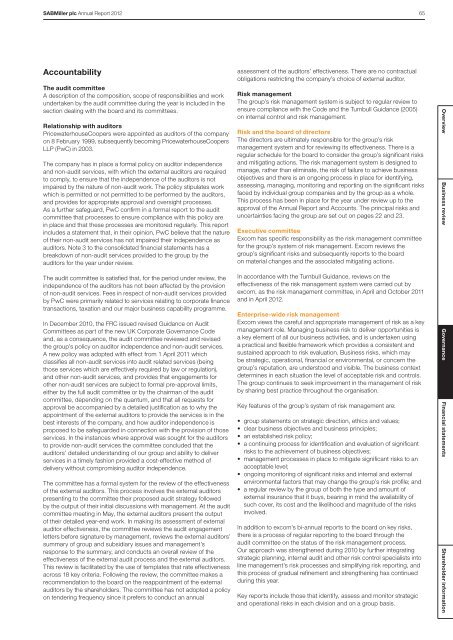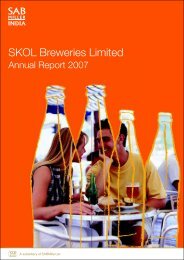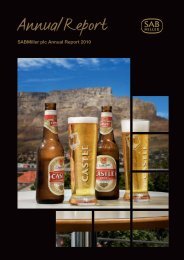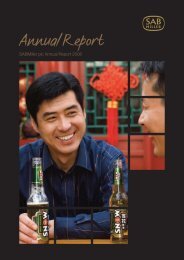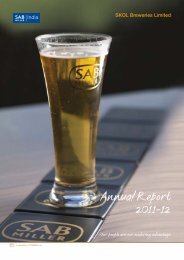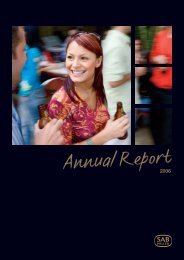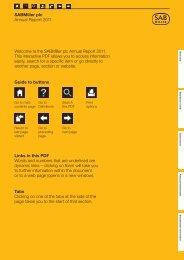Download Sabmiller Plc Annual Report 2012 PDF
Download Sabmiller Plc Annual Report 2012 PDF
Download Sabmiller Plc Annual Report 2012 PDF
Create successful ePaper yourself
Turn your PDF publications into a flip-book with our unique Google optimized e-Paper software.
SABMiller plc <strong>Annual</strong> <strong>Report</strong> <strong>2012</strong> 65AccountabilityThe audit committeeA description of the composition, scope of responsibilities and workundertaken by the audit committee during the year is included in thesection dealing with the board and its committees.Relationship with auditorsPricewaterhouseCoopers were appointed as auditors of the companyon 8 February 1999, subsequently becoming PricewaterhouseCoopersLLP (PwC) in 2003.The company has in place a formal policy on auditor independenceand non-audit services, with which the external auditors are requiredto comply, to ensure that the independence of the auditors is notimpaired by the nature of non-audit work. The policy stipulates workwhich is permitted or not permitted to be performed by the auditors,and provides for appropriate approval and oversight processes.As a further safeguard, PwC confirm in a formal report to the auditcommittee that processes to ensure compliance with this policy arein place and that these processes are monitored regularly. This reportincludes a statement that, in their opinion, PwC believe that the natureof their non-audit services has not impaired their independence asauditors. Note 3 to the consolidated financial statements has abreakdown of non-audit services provided to the group by theauditors for the year under review.The audit committee is satisfied that, for the period under review, theindependence of the auditors has not been affected by the provisionof non-audit services. Fees in respect of non-audit services providedby PwC were primarily related to services relating to corporate financetransactions, taxation and our major business capability programme.In December 2010, the FRC issued revised Guidance on AuditCommittees as part of the new UK Corporate Governance Codeand, as a consequence, the audit committee reviewed and revisedthe group’s policy on auditor independence and non-audit services.A new policy was adopted with effect from 1 April 2011 whichclassifies all non-audit services into audit related services (beingthose services which are effectively required by law or regulation),and other non-audit services, and provides that engagements forother non-audit services are subject to formal pre-approval limits,either by the full audit committee or by the chairman of the auditcommittee, depending on the quantum, and that all requests forapproval be accompanied by a detailed justification as to why theappointment of the external auditors to provide the services is in thebest interests of the company, and how auditor independence isproposed to be safeguarded in connection with the provision of thoseservices. In the instances where approval was sought for the auditorsto provide non-audit services the committee concluded that theauditors’ detailed understanding of our group and ability to deliverservices in a timely fashion provided a cost-effective method ofdelivery without compromising auditor independence.The committee has a formal system for the review of the effectivenessof the external auditors. This process involves the external auditorspresenting to the committee their proposed audit strategy followedby the output of their initial discussions with management. At the auditcommittee meeting in May, the external auditors present the outputof their detailed year-end work. In making its assessment of externalauditor effectiveness, the committee reviews the audit engagementletters before signature by management, reviews the external auditors’summary of group and subsidiary issues and management’sresponse to the summary, and conducts an overall review of theeffectiveness of the external audit process and the external auditors.This review is facilitated by the use of templates that rate effectivenessacross 18 key criteria. Following the review, the committee makes arecommendation to the board on the reappointment of the externalauditors by the shareholders. The committee has not adopted a policyon tendering frequency since it prefers to conduct an annualassessment of the auditors’ effectiveness. There are no contractualobligations restricting the company’s choice of external auditor.Risk managementThe group’s risk management system is subject to regular review toensure compliance with the Code and the Turnbull Guidance (2005)on internal control and risk management.Risk and the board of directorsThe directors are ultimately responsible for the group’s riskmanagement system and for reviewing its effectiveness. There is aregular schedule for the board to consider the group’s significant risksand mitigating actions. The risk management system is designed tomanage, rather than eliminate, the risk of failure to achieve businessobjectives and there is an ongoing process in place for identifying,assessing, managing, monitoring and reporting on the significant risksfaced by individual group companies and by the group as a whole.This process has been in place for the year under review up to theapproval of the <strong>Annual</strong> <strong>Report</strong> and Accounts. The principal risks anduncertainties facing the group are set out on pages 22 and 23.Executive committeeExcom has specific responsibility as the risk management committeefor the group’s system of risk management. Excom reviews thegroup’s significant risks and subsequently reports to the boardon material changes and the associated mitigating actions.In accordance with the Turnbull Guidance, reviews on theeffectiveness of the risk management system were carried out byexcom, as the risk management committee, in April and October 2011and in April <strong>2012</strong>.Enterprise-wide risk managementExcom views the careful and appropriate management of risk as a keymanagement role. Managing business risk to deliver opportunities isa key element of all our business activities, and is undertaken usinga practical and flexible framework which provides a consistent andsustained approach to risk evaluation. Business risks, which maybe strategic, operational, financial or environmental, or concern thegroup’s reputation, are understood and visible. The business contextdetermines in each situation the level of acceptable risk and controls.The group continues to seek improvement in the management of riskby sharing best practice throughout the organisation.Key features of the group’s system of risk management are:• group statements on strategic direction, ethics and values;• clear business objectives and business principles;• an established risk policy;• a continuing process for identification and evaluation of significantrisks to the achievement of business objectives;• management processes in place to mitigate significant risks to anacceptable level;• ongoing monitoring of significant risks and internal and externalenvironmental factors that may change the group’s risk profile; and• a regular review by the group of both the type and amount ofexternal insurance that it buys, bearing in mind the availability ofsuch cover, its cost and the likelihood and magnitude of the risksinvolved.In addition to excom’s bi-annual reports to the board on key risks,there is a process of regular reporting to the board through theaudit committee on the status of the risk management process.Our approach was strengthened during 2010 by further integratingstrategic planning, internal audit and other risk control specialists intoline management’s risk processes and simplifying risk reporting, andthis process of gradual refinement and strengthening has continuedduring this year.Key reports include those that identify, assess and monitor strategicand operational risks in each division and on a group basis.Overview Business review Governance Financial statements Shareholder information


